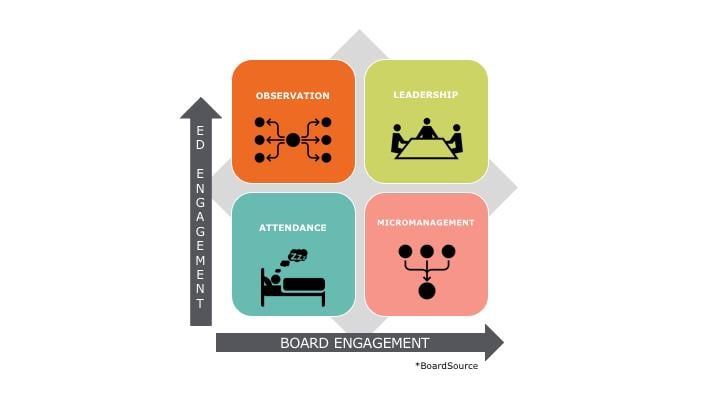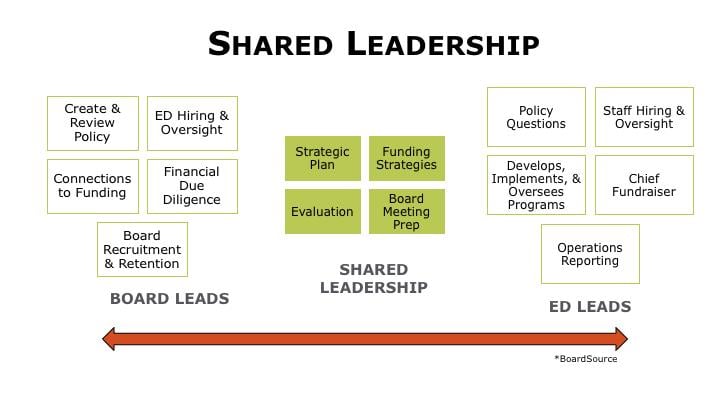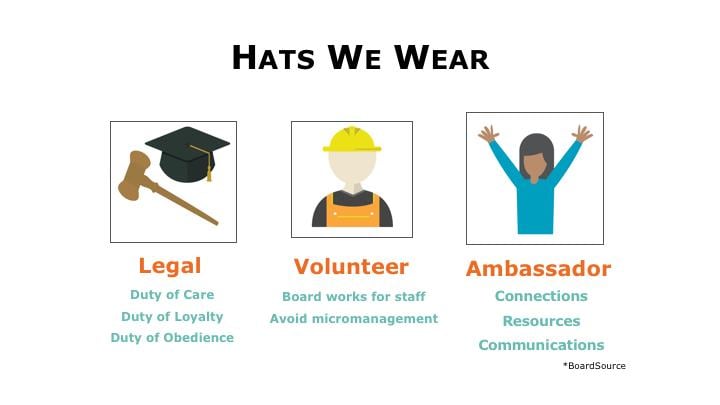Shared leadership between nonprofit board members and the chief executive is a commonly invisible issue or at least widely misunderstood. Who leads the charge when it comes to strategic planning? Fundraising? Operations?
Governance is a shared responsibility between the chief executive (CEO or executive director) and the board of directors as a collective. Chief executives provide the board with valuable perspectives for informed decision making and serve as the liaison between the board and staff. To avoid actual or perceived conflicts of interest, however, BoardSource recommends that chief executives serve as non-voting members of the board, unless not permitted by law.
The board relies on the expertise of the CEO to help it meet its responsibilities: setting organizational direction, providing oversight, and ensuring necessary resources. With the information provided, board members can effectively fill their roles by asking three key questions: What? How? Why? Examples include the following:
WHAT?
- What is our organization’s capacity?
- What does ultimate success look like?
- What matters most to us?
HOW?
- How does this serve our mission?
- How does it fit our strategic goals?
- How might this be a challenge for us?
WHY?
- Why is this important right now?
- Why should we consider other options?
- Why is this relevant to our stakeholders?
The CEO is also reliant on the board to set the priorities for the organization that he or she will implement through staff, volunteers, and donors. Without a clear strategic direction, it’s difficult for a CEO to know when to say “yes” to opportunities for the organization — or, much more challenging, when to say “no.”
Ideally, an organization will find that sweet spot of shared leadership where the CEO and board are working in harmony. Finding this place is in consistent flux, however, as external and internal factors impact the organization. What we do know is that there are comparative models to avoid:
Governance as attendance: Essentially this type of governance is when the CEO and the board are asleep at the wheel. No one is really taking initiative, which may lead to complacency and perhaps even dissolution.
Governance as observation: In this circumstance, the CEO is guiding all the governance of the organization. In many cases, this is when the board is acting as a “rubber stamp” for decisions. The members are not asking the questions of what, how, and why. We often see this in organizations where there is a founder in the CEO role.
Governance as micromanagement: This scenario reflects when the board has displaced the CEO to the point that the CEO may be powerless in governance responsibilities. Often times the board is highly involved in operations rather than delegating those responsibilities to the CEO or wearing the proper “hat” — legal, volunteer, or ambassador (see below for more information).

How can an organization find the ideal shared, governance-as-leadership experience?
The first thing is to explore existing understanding of board and staff (via the CEO) roles. I often use a shared responsibilities checklist provided by BoardSource to explore this. It uncovers questions and answers related to best practices.
The second thing is to understand the differences and similarities between corporate and nonprofit boards. Many board members come from the corporate world. While there is cross-over, it is also important to capture what is unique among sectors.
For example, on corporate boards the CEO is responsible for both creating and implementing the strategic plan as assigned by the board. In a nonprofit, the board and chief executive are both typically involved in the strategic planning process and co-create the plan or directional framework. The board then provides oversight of the chief executive’s implementation of the plan through staff and volunteers.
Third is to learn who leads various activities in the governance function. It’s not to say that one entity — CEO or the board of directors — is the only one responsible or involved, but to clarify who is ultimately the entity leading the effort. For example, the board is responsible for recruiting its own board members while the CEO is involved in helping to funnel candidates and provide feedback.
In some cases, there are completely shared activities, such as performance evaluation or assessment. Board self-evaluation and CEO performance assessments are two examples where board members and the chief executive should participate equally.
Here’s a quick reference of what shared leadership looks like:

I often refer to the role of the board in term of the various hats board members wear and their work in operations. Below is an image I use to help board members know where they need to be in terms of “altitude” within the organization as well as the hats they should wear (legal, volunteer, ambassador) at different times. Ask yourself as a board member, “What hat am I wearing and what hat should I be wearing?” Also, “Do I need to come up in altitude and wear a legal hat or get into the weeds wearing a volunteer hat?”

The board chair plays an essential role in shared leadership. Serving as the board’s representative, he or she connects with the CEO on a consistent basis to ensure governance work is moving forward efficiently and effectively.
Like so much of board governance, shared leadership is a combination of art and science. The science is knowing the best practices, and the art is feeling through organizational and personal dynamics to best serve the organization for the greatest short- and long-term impact.
What does shared leadership look like in your organization? Are there ways you can improve? How so? What are helpful examples you might be able to share with others here?
Do you still have questions about shared leadership?


